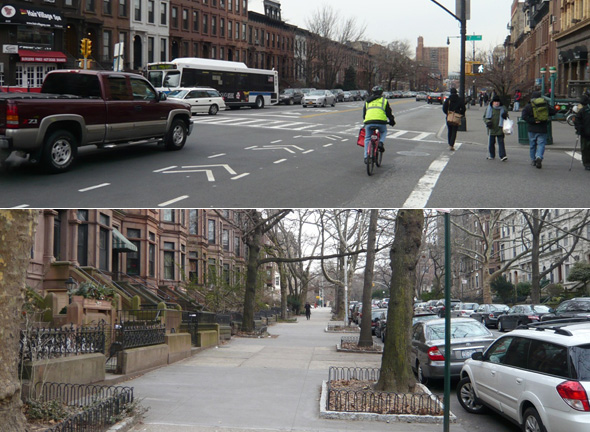Strolling up 3rd Street in Park Slope from 7th Avenue toward Prospect Park, it’s easy to see this is one of the most magnificent streets in what is, let’s face it, one of the prettiest neighborhoods in the city. The homes, built in the late 19th century and often clad in white stone, are set back further. The double flanking of trees lend a calming tone. A bike lane is set along one side of the one-way street.
But what’s most luxurious about this street, if not consciously noticed by its users, are the expansive sidewalks, about 8 paces, which is roughly twice as wide as the sidewalks on surrounding streets. The wide sidewalks on 3rd Street provide room for several people to walk side by side in one direction, without playing the game of dodge a person so common in New York. It’s a strolling street.
If you walk south from 3th Street for just six blocks, you come to a very different sort of street, 9th Street. It’s probably one of the least pleasant streets in the Slope. The sidewalks are narrow. The car portion of the street is wide. A torrent of cars and trucks pour up and down it, making their way to and from the Gowanus Canal, Court Street, and Red Hook. The street has bike lanes on each side, but this is still a chaotic and risky place to cycle, given the trucks and double-parking.
But here’s the thing. Did 9th Street used to be like 3rd Street? My eye, somewhat attuned to urban geography, sees evidence that the answer is yes. Both of the streets, measured by the distance from the homes on each side to each other, are wider than surrounding streets. Both are flanked by particularly elegant townhouses. I wonder if 9th Street, now so chaotic and workhorse like, used to be a grand strolling street leading up to the prominent entrance to Prospect Park where the statue of General Lafayette awaits you.
What I bet happened is that at some point in the last century the city grabbed some of the width from the sidewalks and setbacks of 9th Street, and gave it over to cars, converting 9th street into a car artery, decidedly unpleasant. I bet the political power of the residents of these beautiful townhouses had reached a nadir, allowing the city to decrease the charm of their street and thus their property values.
So far I have found little evidence to back up my thesis. A friend of mine in his 50s who grew up on 9th Street near 7th Avenue said he remembered -- or at least had heard about -- the streetcars that used to run down 9th Street. This makes sense. Park Slope and all of brownstone Brooklyn are streetcar suburbs, developed around the streetcar lines that were laid out in the late 19th century.
I checked with some sources inside the city’s Department of Transportation. They said "uummm, we’ll get back to you on that," but so far they haven’t. I’m hoping some Park Slope historian will come forward.
Whatever the street’s history, to understand these two streets more deeply, and to see if my hunches had some facts behind them, I paced off the elements of each street.
Each of the sidewalks on 3rd street was eight of my long paces wide, with the setbacks to the buildings taking up another eight paces, and the street to its middle taking up six paces.
The sidewalk on 9th Street was only four paces wide, or maybe four-and-a-half. The setbacks on 9th Street were about five to five-and-a-half paces. The car portion of the street, on the other hand, took up 11 or 12 paces, perhaps twice the width of 3rd3 street. My paces were not exact, so these measurements are loose.
Looking more closely at 3rd street, I found that it does an odd thing between 6th and 7th avenues. The sidewalks narrow a few feet, and the street widens, and the row of trees takes a step back toward the houses. Just for this one block, the street is wider, before returning to wider sidewalks and narrower street after 6th Avenue. Why did this happen? The extra car-street space is not used for anything now. Is this evidence that the city once started to do to 3rd Street what it did to 9th Street?
Whatever the history of 9th Street, here’s a radical question: Could 9th Street be more like 3rd Street, today? Could the city widen the sidewalks to eight paces, and reduce the street width to four paces as on 3rd street, while keeping the bike lane? And would this be a good thing?
This is not a question that is only of interest to people in Park Slope. During the 20th century, the city widened and increased traffic lanes, at the expense of sidewalks, setbacks and park space, all over the city. Park Avenue used to have more park down the middle of it before World War II. Third Avenue in Manhattan, where I used to live, used to have wider sidewalks, I was told. Dozens if not hundreds of smaller streets all over the city were widened, at the expense of walkers, to make way for the new master, the automobile.
I’ll list some positives and negatives of making 9th Street more like 3rd Street. The negative would be that it would reduce the street’s utility as a thoroughfare, one meant to “clear” traffic, and carry it swiftly from one part of the city to another. That’s the only negative I can think of. The positives would be many. Bicycling would be safer. Strolling would be nicer. Significantly, the values of the homes along the street would almost certainly increase, perhaps more than making up for the cost of the infrastructure work.
Should 9th Street be more like 3rd Street? It’s a question worth asking.






